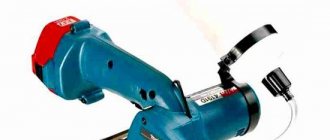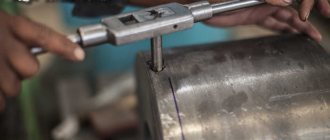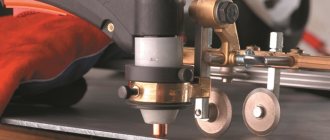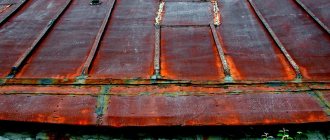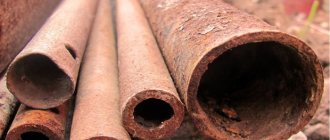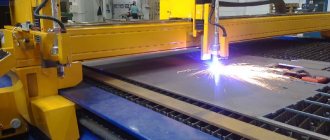Plasma cutters are actively used in metalworking enterprises. They are also sometimes used on the farm: in private homes or garages. With this tool you can quickly obtain metal of the required size, and the quality of the cut is quite high. Hot plasma cuts almost any metal. The main advantage over a grinder is the ability to make curved cuts without the need for finishing. It is worth considering the TOP 10 models that are on the market today.
Plasma cutter device
A modern plasma cutter, regardless of its size, consists of several elements that are required:
- burners;
- power supply;
- ground cable;
- compressor/compressed air cylinder.
Plasma cutter device and principle of operation
It is also possible to supplement the device with additional components to make it more convenient to work. These include a display, various protection systems and much more.
Operating principle
What is plasma
We’ve figured out the devices of the device, now let’s look at how a plasma cutting machine works, and what the word “plasma” actually means. So, plasma is air or other gas heated to a high temperature and in an ionized state. The heating temperature can reach 30,000 degrees.
The diagram shows the principle of plasma cutting
The operating principle of the device is as follows:
- When the ignition button is pressed, high frequency currents are supplied to the electrode;
- A pilot arc is formed between the nozzle and the electrode, the temperature of which reaches 8000 degrees;
- Then compressed air is supplied to the nozzle;
- The air breaks through the arc, as a result of which it heats up and increases in volume a hundred times. In this case, it is ionized, and the air acquires conductive properties;
- When the plasma comes into contact with the workpiece, a cutting arc is formed, and the pilot arc goes out. As a result, the metal is easily cut, and the air is blown away from the cutting line.
You can make a plasma cutting machine yourself. For this, they usually use a welding machine inverter, but you can make the device “from scratch” using the diagrams available on the Internet.
A homemade plasma cutter will cost you several times cheaper than a branded one
Principle of operation
The inverter produces direct current. Depending on the model, the mains voltage is 220V or 380V. The former can be used at home, but the latter are three-phase and can only be used in businesses. When used at home, the wiring may fail, resulting in a fire.
During operation of the device, the electric arc is tensioned. Compressed air is supplied to it, and during heating it is transformed into plasma. Its temperature reaches 20,000 degrees, which allows you to quickly cut almost any metal.
Here's how metal is cut with a plasma cutter:
- After switching on, voltage is applied, which allows you to form a special arc for cutting metal. The compressor begins to supply compressed air to the nozzle. When heated, it turns into plasma.
- The worker brings the tool to the workpiece. The arc closes on the metal, thanks to which it is cut. Plasma parameters can be adjusted independently.
- After completing the work, the welder needs to remove the plasma cutter and turn it off. The air will be supplied for a while to cool the tool nozzle faster.
Video - How a plasma cutter works
Types of plasma cutting devices
A device for air plasma cutting of metal can have different dimensions and purposes. To perform precise cutting of metals, computer-controlled machines are used.
The price of such an installation can be hundreds of thousands of rubles, so purchasing for private use is impractical.
A unit for household use can be purchased at an affordable price, but the thickness of the workpiece processed for such devices usually does not exceed 12 mm. The main advantage of household models is their mobility. Household plasma cutting machines can be used by repair teams to carry out work directly at the accident site.
In addition to dimensions and power, plasma cutting machines can be divided according to the type of electrical energy transformation .
Inverter models are usually used in everyday life, due to the relatively low power of such devices. The undoubted advantage of this type of plasma cutter is its higher efficiency, which in modern devices can reach a value 30% greater than that of transformer models.
Transformer plasma cutters have significantly greater weight and electric arc power, but due to high energy consumption they are used mainly only in production. Among the main positive qualities of the transformer model is high reliability. Such devices tolerate power surges well, while inverter devices can completely fail if the power supply is unstable.
Most popular models
Among the plasma cutting machines, there are several models that have proven themselves in operation.
1. Multiplaz-15000 - operates exclusively from a three-phase electrical network.
The unit is not only designed for cutting, but also for soldering any conductive metals.
Multiplaz-15000 allows you to perform high-quality metal cuts thanks to a narrowly directed plasma jet. Thanks to the original design using water vapor as a plasma-forming substance, working with a plasma cutting machine becomes not only highly productive, but also absolutely safe for the environment.
Using this device, you can easily process metals up to 50 mm thick. The cost of the car is 170,000 rubles.
Video:
2. Cedar CUT 160I is a high-performance device (costing RUB 157,000). Operates from a three-phase voltage network of 380 V.
To operate the device, you need a compressor that will supply compressed air to the burner. The device can be connected to a portal with software controls to perform work more accurately and increase the speed of metal cutting. At a high cutting speed, Cedar cut 160i allows you to make a perfectly even cut, which does not require additional processing for further welding of metal parts.
This device implements a non-contact initial arc igniter system, which also simplifies and speeds up the work process. The thickness of the processed metal recommended by the manufacturer is 40 mm.
3. RSA-120 IGBT - ideal for cutting not only steel, but also non-ferrous metals. Using an innovative method of switching electric current allows you to increase the efficiency of the device, as well as significantly reduce the likelihood of failure due to changes in mains voltage.
RSA-120 IGBT is a professional device that allows you to operate under heavy load for a long time. The design of the device has built-in protection against overheating, as well as against phase loss and insufficient pressure of air supplied to the burner.
RSA-120 can only be connected to a three-phase network with a voltage of 380 volts. The average price of a plasma cutter is 140,000 rubles.
4. SVAROG REAL CUT 45 is a household plasma cutter that can be connected to a regular 220 V power supply. The device is capable of cutting any conductive metal with a thickness of no more than 12 mm. Despite the low cost (RUB 19,000) and low power, reviews of this device are extremely positive.
SVAROG REAL CUT 45 belongs to the class of inverter devices, so maximum performance will be ensured during operation. The current power consumed by the device is only 6.2 kW, so there will be no disruptions in the home network when using the device.
This model is equipped with a smooth current regulator, which allows you to ideally configure the device for cutting metals of various thicknesses.
5. Resanta IPR-40K is a domestically produced plasma cutter for household use, characterized by high quality and reliability. Price 20,000 rub.
The device is lightweight, making it ideal for home use. To operate the plasma cutter, you just need to connect the device to a regular 220 V outlet, after which you can cut any metal up to 12 mm thick.
6. MASTER CUT-40 is a compact, lightweight and easy-to-use device for plasma cutting of metals.
The device is connected to a 220 V home electrical network. MASTER CUT-40 is perfect for home use by both beginners and experienced craftsmen.
The weight of the device is only 8 kg, so MASTER CUT-40 can be used with maximum efficiency in small construction teams. The cost of the inverter is 23,000 rubles.
The listed device models differ significantly from each other only in power, the remaining characteristics are at a fairly high level, so the choice of device should first of all take into account the possibility of connecting to the appropriate electrical network, as well as the thickness of the metal being processed.
Scope of application
Today plasma cutters are used in the following areas:
- shipbuilding;
- aircraft manufacturing;
- construction;
- various production areas.
Important! At home, a plasma cutter can also be a good helper, but you need to keep in mind that the tool is quite expensive. Therefore, it is advisable to buy it if you need to frequently cut metal.
It is worth considering the main advantages and disadvantages of this tool.
| pros | Minuses |
|
|
Advantages and disadvantages of units
To understand which plasma cutter is better, you need to know the advantages and disadvantages of the devices. Benefits include:
in addition to ordinary metal, you can cut aluminum, stainless steel or cast iron;- no surface preparation required. The presence of rust and paint is allowed;
- the cut is smooth without scale;
- even with a small thickness of the workpiece there is no thermal deformation of the surface;
- safety in operation;
- possibility of forming complex cuts.
Types of plasma cutters
Despite the large number of models on the market, there are several ways to divide them into types.
- By type of cutting: manual and automatic. The first ones are suitable for the garage and take up little space. The scope of application of the latter is wider. Depending on the technical characteristics, they can be used in small workshops or large factories. Manufacturers often allow you to automate the operation of the device using a CNC machine.
Manual plasma cutter, automated using a CNC machine - By gas type. Manufacturers offer devices that operate on compressed air, argon, oxygen, nitrogen or various mixtures.
- According to the method of arc ignition: contact, pneumatic and high-frequency. The contact method is used in household models. Pneumatic ones are used most often as this type is easy to use and can also save gas.
- By cooling method: air and liquid. Air cooling is used on semi-professional models. The cooling rate is much lower than when using liquid.
These are the main ways to separate plasma cutters.
Tips and recommendations when choosing plasma cutters
There are several recommendations from experts who can help you choose the optimal model. Here's what you need to pay attention to before purchasing:
- metal thickness. The specifications indicate the maximum thickness. But you need to understand that different metals have different densities, so the data in the instructions are unified;
- The duration of operation allows you to understand how long the plasma cutter can operate without overheating. For domestic use, you can use models with an indicator of 40%, but for production you need at least 60-80%;
- the power of the device must be at least 20% higher than that required for processing a particular workpiece. This will reduce the load on the tool and increase the speed of metal processing;
- hose package length. It varies from 1.5 to 8 meters. When working with large workpieces, it is better to buy the maximum length so as not to waste time rearranging the plasma cutter.
Video - How to choose a plasma cutter
Important! It is also worth paying attention to the equipment if the budget is very limited. Devices with a built-in compressor are more expensive. But if it is not included in the kit, you will need to make an additional purchase, because without a compressor you will not be able to use a plasma cutter. The display may be a useful feature, but it does not affect the performance of the instrument.
These are the main nuances that are worth remembering when buying a plasma cutter. By choosing from the above tools, you can make a great purchase at a decent price. But new models are constantly appearing on the market, so it is important to understand what to look for when choosing. This will allow you to buy a tool that will really be needed in a particular case.
Video - How to assemble a plasma cutter with your own hands and what it consists of
Voting for the best plasma cutter
Which plasma cutter would you choose or recommend?
ESAB CUTMASTER 120
11.11 % ( 1 )
BLUEWELD Best Plasma 100
0.00 % ( 0 )
Telwin SUPERIOR PLASMA 90 HF
11.11 % ( 1 )
Grovers CUT 40 compressor
22.22 % ( 2 )
Fubag PLASMA 65 T
11.11 % ( 1 )
Svarog REAL CUT 70 (L204)
0.00 % ( 0 )
Fubag PLASMA 40
11.11 % ( 1 )
RESANTA IPR-40
11.11 % ( 1 )
Aurora AIRHOLD 42
11.11 % ( 1 )

